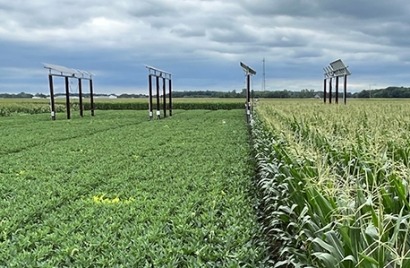
The patent-pending Purdue structures and software optimize food production for farmers and maximize solar energy production. Research about the improved agrivoltaic panels was published in the January 2023 issue of the peer-reviewed IEEE Journal of Photovoltaics. It also has been published in the Journal of Photovoltaic Technology and Nature Sustainability and presented at IEEE Photovoltaic Specialists conferences.
Rakesh Agrawal, the Winthrop E. Stone Distinguished Professor of Chemical Engineering from Purdue’s Davidson School of Chemical Engineering, said farmland in the United States already is used to generate energy from wind.
“But wind farms depend on the availability of wind energy and are limited to certain regions of the world,” Agrawal said, “whereas sunlight is available at most locations where farming is done, and photovoltaics, or PV, can be deployed at a much larger scale. However, use of PV panels on agriculture farmland requires sharing solar photons between food and energy that must be carefully optimized.”
Traditional agrivoltaic structures cast shadows, which decrease crop yield. Mitch Tuinstra is a Purdue University professor of plant breeding and genetics, the Wickersham Chair of Excellence in Agricultural Research and scientific director of the Institute for Plant Sciences in the College of Agriculture. He said traditional structures are incompatible with large-scale agriculture because they are mounted high to allow farm equipment to freely move around them.
“The increased height requires a deeper foundation for the structures, which dramatically increases the cost of the solar farms,” Tuinstra said. “Our modules are mounted much lower, comparable to traditional solar farms, which makes our system more affordable and decreases the time needed for a return on investment.”
The Purdue agrivoltaic structures use a dual, off-axis rotation system and sensors to optimize the amount of electricity generated and the amount of light that crops receive.
“The key idea is that when farm equipment needs to pass, the modules will rotate to form a near-vertical structure,” Tuinstra said. “At other times, the modules will track the sun as usual.”
Muhammad Ashraful Alam, the Jai N. Gupta Professor of Electrical and Computer Engineering in the Elmore Family School of Electrical and Computer Engineering, said the Purdue agrivoltaic structures can be implemented for full-scale farming and use current farm equipment.
“The system is designed with row crops in mind like corn, soybeans, wheat and rice,” Alam said. “The dimensions of these structures have been fine-tuned to allow sunlight, rain and shadows to reach plants as needed. They also withstand harsh weather conditions including heavy rain and strong wind.”
Agrawal, Alam and Tuinstra created the structures and software and disclosed them to the Purdue Research Foundation Office of Technology Commercialization, which applied for a patent on the intellectual property.
The next steps to bring these improved agrivoltaic structures to market include partnering with a solar energy developer.
“This is translational research. An industrial partnership or partnership with solar farm installation companies, preferably in Indiana, is the next step,” Tuinstra said.
Information provided by Purdue University

